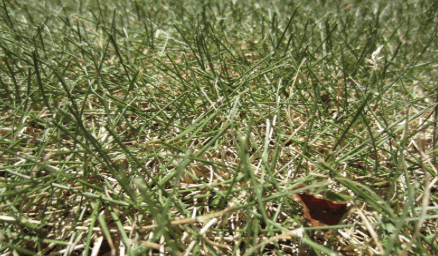Please watch your email inbox for a chance to save 5% on your seeding this fall. Emails will be sent out around the second week in July. Book Now For Fall Fescue Seeding and Receive 5% Early Booking Discount Fescue needs to be seeded in September and early October; not the spring. Tall Fescue in… Read more »
Please watch your email inbox for a chance to save 5% on your seeding this fall. Emails will be sent out around the second week in July.
Fescue needs to be seeded in September and early October; not the spring. Tall Fescue in the Transitional Zone faces many challenges during the year that can create turf damage or injury. This is why it is important to seed your fescue lawn every fall. Diseases can be one of the causes of turf damage. Brown Patch Fungus, Dollar Spot and Pythium can be devastating to fescue. Extended dry periods along with the heat make for a damaging combination on all turf types. In fact, when the ground temperatures reach the mid 80 degrees to low 90 degrees, cool season grasses (Fescue and Bluegrass) root system stops developing and will lose root mass that supports plant survival. Extended dry periods exacerbate cool season turf decline. Many people cannot switch to a warm season turf due to shade conditions in the lawn. All warm season turf types require full sun (not filtered) for at least 8 hours to grow properly and survive.

Summer is turf disease season for cool season and warm season grasses. Brown patch fungus on Fescue started in early May this year. We have seen sporadic cases of Pythium and Dollar Spot on warm season turf. Brown Patch Fungus activity has been high on Fescue at the end of June due to the high humidity and thunderstorms. It is always better to control diseases preventively vs. curatively.
It is not uncommon to have some crabgrass germinating in the lawn around the end of July through August. The pre-emergent applied earlier in the year will start to degrade and break down. Generally, Crabgrass will germinate in areas with thin turf, along roadways and other hard surfaces and in high spots of the lawn. Pre-emergent breakdown is especially important in Fescue lawns because seeding needs to take place starting at the end of August to mid-October. Fescue seedlings would not be able to survive with pre-emergent still bonded to the soil particles.
You also may notice an increase in broadleaf weed germination at this time too. Pre-emergent Crabgrass control also helps control broadleaf weed germination.

Yellow Nutsedge is a prolific and very difficult weed to control in many lawns and natural areas. Nutsedge is not a broadleaf weed or grassy weed but is in the sedge family. Yellow Nutsedge is a summer perennial that flourishes from April/May to around September/October. It reproduces from tubers (nutlets) under the soil and can spread from rhizomes. Each plant can produce hundreds of tubers during its growing season. These new tubers will be new plants in the years to come. Nutsedge will have a triangle stem and is easily felt when you twirl a stem between your thumb and forefinger. Yellow Nutsedge will grow much faster than the existing turf and will have a thin shiny appearance.
Post-emergent broadleaf weed controls for weeds like clover and dandelions will not control Nutsedge. There are limited products available for controlling Nutsedge and all of them require frequent applications over multiple years to offer acceptable control.

Heat/dry stress is often misdiagnosed as a fungus or other issue. Signs of dry/heat stress include: a darker color to the lawn, visible footprints, and a leaf blade that is folded and thin looking. The grass blade appears to be almost straw-like on all types of turf, including Bermuda and Zoysia. If the lawn looks ok in the morning then looks poor in late afternoon, it is probably heat/dry stress. Tall Fescue will usually go into a semi-dormant state and shut down. Most of the turf will bounce back with cooler temperatures and rainfall. It is important for the fescue to be healthy from proper fertility and a 3.5” to 4.0 mowing height before, during and after the semi-dormant state. We have about two more months of these climatic conditions.
Many people are under the impression that Warm season turf lawns like Bermuda and Zoysia cannot experience heat/dry related injury/stress during summer. However, warm season turf grasses are just more heat/dry tolerant than warm season turf. They generally recover from these stresses better than a cool season turf. Warm season and cool season turf stress is exacerbated when the turf is growing in poor conditions (i.e. shade, compact soil, etc.) and/or struggling to recover from a harsh Transitional Zone winter. Like Tall Fescue, most of the turf will bounce back if the turf was in good health.
Warm season turf is heat/dry tolerant but not exempt from experiencing the same conditions as cool season turf like Fescue during hot dry weather. Tolerance means it can tolerate those type of conditions longer and have the ability to generally recover faster.
Fairway Green Mosquito Control Program has been very successful. We are receiving praise from customers that feel they can be in their yards during the summer again. Safely enjoy the outdoors this summer by controlling disease-ridden mosquitos at home
We all know Mosquitos transmit diseases like West Nile Virus, Encephalitis, Chikungumya and Zika! Fairway Green’s Mosquito Control program can help control Mosquitos giving you and your family peace of mind.
Receive $10.00 off your first application. *New Mosquito Control customers only; cannot be combined w/other offers.